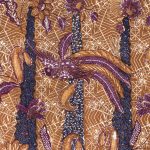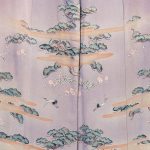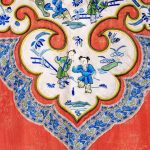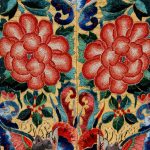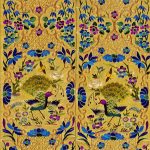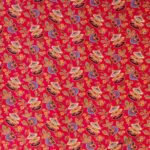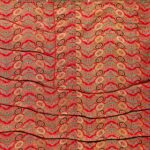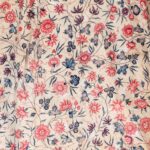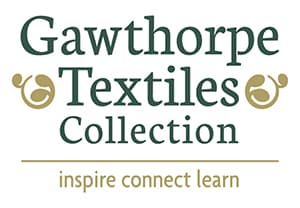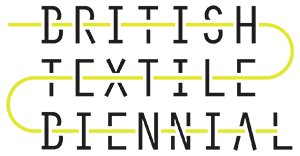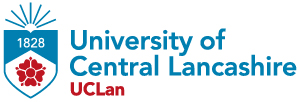This intricately patterned sarong from Indonesia is a beautiful example of the batik method. The complex design features birds, spiders, beetles and other insects worked in shades of deep blue and brown. Each colour would require a new layer of wax to be laid over the relevant sections of fabric, dyed, then washed free of […]
View moreThis sample is one of a set of over 90 print samples attributed to the Robert Hindle & Co Print Works in Sabden, Lancashire. The vibrant colours of the samples are a perfect example of the impact that aniline dyes had on the dyeing and printing industries. The first aniline dye was mauveine or ‘Perkin’s […]
View moreThis sample is one of a set of over 90 print samples attributed to the Robert Hindle & Co Print Works in Sabden, Lancashire. The vibrant colours of the samples are a perfect example of the impact that aniline dyes had on the dyeing and printing industries. The first aniline dye was mauveine or ‘Perkin’s […]
View moreThis sample is one of a set of over 90 print samples attributed to the Robert Hindle & Co Print Works in Sabden, Lancashire. The vibrant colours of the samples are a perfect example of the impact that aniline dyes had on the dyeing and printing industries. The first aniline dye was mauveine or ‘Perkin’s […]
View moreJapanese hiki-furisode-style robe, of ombre dyed silk crepe with padded hem and long sleeves and lined with bright red silk. The robe has blank spaces for crests in the small circles either side of the front opening. The beautiful mauve ombre provides a backdrop for the delicate painted motifs depicting auspicious cranes along with pine […]
View moreThis Qing era robe has a typical straight cut, loose fitting body with square sleeves. The simple shape is designed to make efficient use of narrow widths of silk so that as little as possible of the expensive silk fabric is wasted when the garment is constructed. The main fabric is a lightweight silk with […]
View moreSleeve bands were decorative cuffs and would have decorated the bottom edges of the sleeves on a traditional robe. They often featured designs that were a near perfect mirror image of one another so that when the hands were clasped in front of the body and tucked slightly into the opposite sleeve, the designs would […]
View moreSleeve bands were decorative cuffs and would have decorated the bottom edges of the sleeves on a traditional robe. They often featured designs that were a near perfect mirror image of one another so that when the hands were clasped in front of the body and tucked slightly into the opposite sleeve, the designs would […]
View moreThis yellow brocaded silk was probably intended for use as garment fabric – perhaps as a woman’s gown or a man’s coat or waistcoat. The silk has a damask weave creating a self-coloured background pattern overlaid with vibrant, colourful floral sprays that have been added with additional brocade weaving. The brocade is further enhanced with […]
View moreThis piece of roller printed cotton has a stylised floral pattern with a slight paisley influence, seen especially in the small patterns used as fillings for larger shapes. The small scale of the printed pattern and light-weight cotton fabric indicate this was probably intended for use as a dress fabric, although this length appears to […]
View moreA full-length petticoat made from brightly coloured printed cotton in vibrant Turkey Red, green and yellow. The lower part of the petticoat is quilted in deep wavy bands decorated with narrow braid and each band is filled with down feathers. As well as being a lightweight but incredibly warm garment these down petticoats also had […]
View moreA skirt or petticoat made from smooth cotton calico and lined throughout with a soft and coarsely woven cotton. The overall floral pattern is hand block printed and dyed using madder and indigo dyes with simple yet effective use of colour shading and layering to give a variety of colour tones using just a few […]
View more